
16
MayFrida Kahlo: Constructing a Life
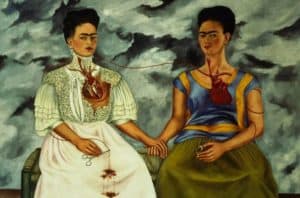 This past weekend was Mother’s Day, or as it is known in our house, the one day of the year my family has to accompany me to an art museum. I chose to go to the Museum of Fine Arts (MFA) in Boston, which is showing an exhibit through June 16th entitled Frida Kahlo and Arte Popular. (The “Arte Popular” refers to traditional Mexican folk art, which Kahlo collected and surrounded herself with.) The exhibit combines Kahlo’s own art with the arte popular that she loved, and asks viewers to consider how these objects impacted her art and aesthetic.
This past weekend was Mother’s Day, or as it is known in our house, the one day of the year my family has to accompany me to an art museum. I chose to go to the Museum of Fine Arts (MFA) in Boston, which is showing an exhibit through June 16th entitled Frida Kahlo and Arte Popular. (The “Arte Popular” refers to traditional Mexican folk art, which Kahlo collected and surrounded herself with.) The exhibit combines Kahlo’s own art with the arte popular that she loved, and asks viewers to consider how these objects impacted her art and aesthetic.
Frida Kahlo is one of the most celebrated artists of the 20th century. She has joined the ranks of Van Gogh and Picasso among others, who are so ubiquitous you don’t even have to know much about art to know who they are. Her work is on a $10 poster in some kid’s dorm room, as well as t-shirts, handbags, toys, and even lipstick. She is no longer just a famous artist, she is pop culture.
Because of this popularity, it can be tempting to dismiss Frida. To say she had a major impact on me seems almost embarrassing; I might as well say “I like art.” Everyone likes Frida, and I tend to be pretty uncomfortable liking something that is extremely popular. If it is everywhere, it becomes less interesting. But of course, this is completely ridiculous – Frida Kahlo is beloved for a reason. Her art is extremely personal. It can be brutal and violent, showcasing her distress for all to see. She is beautiful and powerful; she is pain and beauty. Almost every female artist admires her.
One of the interesting things about Frida is that we don’t just love her art, we love her. We know who she is and what she looks like just as much as we know her painting The Two Fridas. This was intentional and by her design. Her husband, Diego Rivera, was already a famous Mexican painter when her art was recognized and began showing, and she knew what journalists and collectors thought of an artist could be as influential as their work itself (if not more.) So she constructed Frida “the artist” – the face she wanted the world to see.
As a child, her family changed her birth year from 1907 to 1910 to hide the fact that she was developmentally behind when she was entering school, due to illness. As an adult, she kept the 1910 birth year not because she wanted to be seen as younger, but because that was the year of the Mexican Revolution. As a young woman, Frida defied convention and dressed as a man in tailored suits and with short hair. But later, she would commission seamstresses to create elaborate copies of traditional folk dresses that she was sure to be photographed in. She wanted to be seen as a symbol of Mexico, a woman of the people. She would be the embodiment of the strong Mexican Revolutionary.
When Frida Kahlo is talked about, the conversation usually centers around both how personal her art is and how tragic her life was. She poured all of her hopes and sorrows into her art, and pushed the boundaries of how brutal and honest she could be. We look at her work and feel like we know her because she is seemingly showing us pieces of her very soul.
But the MFA show is a little different – a little left of center. We know Frida, but we also know what Frida wanted us to see. She constructed the image of herself with careful thought and planning. Some may see that as a lie – a mask, and feel like we have somehow been cheated out of knowing who she really was.
I like to think a little more hopefully about it. Frida could not help illness and accidents, betrayals and loss. But she surrounded herself with the things she admired and loved. She was a strong, intelligent woman who made herself into the symbol she wanted to show the world. Frida’s work continues to show us that we cannot avoid pain, but we can mold it into something beautiful.
Reading List:
Frida Kahlo: An Illustrated Life by Maria Hesse
Frida: A Biography of Frida Kahlo by Hayden Herrera
The Diary of Frida Kahlo: An Intimate Portrait
Frida Kahlo: The Paintings by Hayden Herrera
Frida Kahlo at Home by Suzanne Barbezat
Nicole Guerra-Coon is the Assistant Children’s Librarian at the Morrill Memorial Library in Norwood, MA.
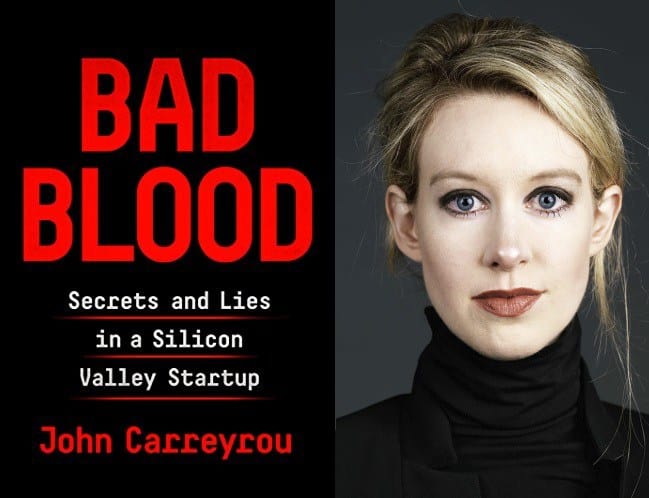
11
MayTheranos, Silicon Valley and Secrets and Lies
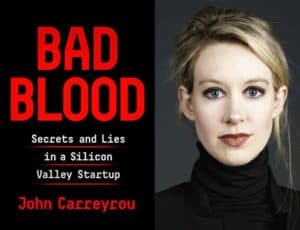 The saga of Elizabeth Holmes and Theranos, her revolutionary (but failed) blood testing company, is a captivating one. While you may have read about it on the Internet, or in news reports last summer, you should read the exposé, Bad Blood by John Carreyrou, published last fall. It is rich with the full account as it was revealed. Carreyrou was (and is) a reporter for the Wall Street Journal. He was hungry for his next new journalistic journey, and a tip about Theranos was just the ticket.
The saga of Elizabeth Holmes and Theranos, her revolutionary (but failed) blood testing company, is a captivating one. While you may have read about it on the Internet, or in news reports last summer, you should read the exposé, Bad Blood by John Carreyrou, published last fall. It is rich with the full account as it was revealed. Carreyrou was (and is) a reporter for the Wall Street Journal. He was hungry for his next new journalistic journey, and a tip about Theranos was just the ticket.
The story of Theranos begins with Elizabeth at 19 – a college dropout – and a concept that depended on all the stars aligning and the pieces of the puzzle falling into place. Most importantly, however, science was required to work.
Detractors have declared that the science was never there to begin with. That it was an absurd quest. Others question if more years and engineering may develop the product that Elizabeth promised – a piece of medical equipment that can deliver accurate results of over 1000 separate tests using only a finger-prick and one drop of blood. Theranos bombed miserably, but not before duping investors and the public.
For those of us hungry for a tragic tale – one that includes billions of dollars and an abundance of Silicon Valley garish living habits, the story does not disappoint. And further, there are continuing acts of trickery, meaningless investments, and the clandestine romance of the two ambitious, vital players.
If you are further intrigued, the HBO documentary, The Inventor: Out for Blood, is an excellent way to watch Elizabeth Holmes in action. It is full of both stills and video that explain some of Elizabeth’s appeal. More importantly, the documentary is full of interviews and testimonies with the whistle-blowers, the detractors, and some of the people who finally began to suspect that Theranos was essentially a house of cards ready to fall. (The HBO documentary is available in several outlets; I found it offered free on a JetBlue flight. Be assured that we will purchase the documentary when it is available on DVD.) Some of Holmes’ charm (whether you find her alluring or not) is explained in the video; at least it is obvious by the men who were beset with her.)
Another, somewhat abridged version of the story is the fascinating six-episode (free) podcast, The Dropout (produced by ABC Radio and ABC News Nightline.) It’s under five hours of listening and rich with the voices involved in the scandal. I listened to the podcast before reading the book; the book is a richer telling of the Theranos tale. I described the podcast as abridged because there are details in Carreyrou’s book that answered many of the questions I had that were left unanswered by the podcast.
The documentary and the podcast left me wanting more. There are hundreds of news articles written about Theranos, both in the ascent of Elizabeth Holmes and in her tragic downfall. In addition, there are short videos and teasers for the documentary.
Many people can’t wrap their head around the magic spell Elizabeth Holmes presented or staged to enchant men like statesmen George Shultz and Henry Kissinger, investors like the Walton (Walmart) family, Rupert Murdock, and Betsy DeVos, and business partners like Walgreen’s. But she did. And easily. They were all hopelessly smitten by the young woman, or by the recommendations of people in high places. For a period of 14 years, Holmes managed to defraud millions of dollars in investments for her Silicon Valley start-up, much of it from Walgreen’s, the pharmacy “trusted since 1901.”
Some of Elizabeth Holmes’ biographical history explains her rise to fame. She was smart. She was pretty. She was ambitious. As a young child, Elizabeth was attracted to both fame and fortune, and she dreamed of becoming recognized for inventing something that would change the world. Some have suggested that her biggest aspiration was to become a billionaire.
Those who interacted with Elizabeth in the classroom or neighborhoods she lived in seemed to be either dazzled or unimpressed by Elizabeth’s poise, composure, and can-do attitude. She was enabled by a family who encouraged her and who had some critical connections through their work and lifestyle. She lived in both Washington, DC and Houston and was afforded splendid opportunities such as summer Mandarin language programs in China. She had no difficulty being accepted to Stanford as a freshman in 2002. By 2004, at the age of nineteen, she dropped out of college, mainly because she was spending more time presenting her ideas to venture capitalists and to influential contacts and wealthy families than she was spending on her studies.
Elizabeth amazingly succeeded in getting her advisor and the Dean of the School of Engineering, Channing Robertson, to join her in her effort to “revolutionize healthcare.” Other influential men in the heart of Silicon Valley, particularly with ties to big money were also impressed, and they all helped her in her spectacular rise. Of note, however, is that none of the investors and board members influential in Holmes’ rise were engineers or scientists. Just like those who knew her as a child, not everyone was charmed with Elizabeth or her company. She had detractors along the way. Many Silicon Valley stars quickly left her company, and some became whistle-blowers. One became so disheartened that he took his own life.
The story of Theranos is actually ongoing, even though the company ceased to exist in 2018 after a three-year investigation by the SEC and others. Elizabeth, the woman who yearned to be the next Steve Jobs, is facing criminal charges of up to 20 years in jail, along with her one-time lover, Ramesh (Sunny) Balwani. The real tragic end may come later this summer after the trial is over.
Charlotte Canelli is the Director of the Morrill Memorial Library in Norwood, MA. Look for her article in the May 9th issue of the Norwood Transcript.

2
MayBorrow a Karaoke Kit, or a Companion Cat
When people think of the public library, I’m fairly certain that books come to mind before all else. Of course libraries have lots of programs and events, and lend a multitude of other materials such as movies, museum passes, and even video games. Nowadays tech-savvy folks also take advantage of “virtual” collections of e-books, audiobooks and streaming video. Over the years the Morrill Memorial Library started thinking outside the box and lending puzzles, knitting needles, cake pans and electronics including Wi-Fi hotspots and GoPro video cameras. Whether we realized it or not at the time, we created, in library parlance, a “Library of Things.”

Lending “things” is becoming increasingly common in public libraries, and here in Norwood the community is embracing the phenomenon. Always aiming to please, we recently expanded our collection of household items, arts and crafts tools, portable electronics, games, and much more.
Did you know that you can come to the library and check out: a metal detector, a device to diagnose why your check engine light is on, a picnic basket, a ukulele, a knife sharpener, or a karaoke machine? How about a food dehydrator, color blind glasses, or a portable turntable that also converts LPs to digital audio files? Now that spring has finally arrived, the library can fulfill many of your outdoorsy needs with: a soil tester, tennis rackets, a cricket set, bike repair tools, and a birdwatching kit.
Purists may wonder why public libraries would venture in this direction and perhaps stray from their traditional purpose. Are they following a fleeting trend? Jumping on the latest bandwagon? I daresay no! On the contrary, we here at the Morrill Memorial Library are staying true to our mission statement: “The Morrill Memorial Library is a vital community center which provides innovative and effective services to all users to enrich their lives with cultural, educational and recreational programs and materials.”
We respond to the needs and wants of the diverse Norwood community, and aim to “enrich lives” in a variety of ways. Of course books and film still play a major role in carrying out this promise, but why not offer “things” as well, allowing visitors to create art, repair their homes, entertain guests, and pick up new hobbies? As with traditional library materials, we help our Norwood neighbors to save money by borrowing rather than buying, or to “try before you buy.” Hearkening back to our mission statement, we certainly hit the mark for innovation when lending out our dog training kit or disco lights. We honor cultural diversity in music traditions, offering patrons maracas, a guiro, an afuche cabasa, and a set of Indian tabla drums to bring home. In our educational role, patrons may learn how to embroider by checking out books on embroidery, accompanied by actual embroidery hoops. As for the recreational goal, the backyard horseshoes set speaks for itself.
You may have seen selections from our Library of Things on display upon entering the library recently, but as we acquired more and more, our staff decided to make room for a large browsing collection on the second floor. Anyone may search our online catalog for “postage scale” or “scientific calculator,” but it sure is fun to window shop the shelves and discover what’s new. Speaking of which, what’s the deal with the “companion cat?!” As much as I’d love to have furry friends in the library and share them with our pet-loving community, I fear we’d be guilty of animal cruelty, or health code violations. We did, however, just acquire a “Joy for All” Companion Cat, by Hasbro. I named him Morrie and adore him already. Turn him on and this cutie meows, purrs and cuddles in response to scratches and pats. At first blush one may think we’ve taken this Library of Things, thing, too far, but allow me to explain. Morrie is not just a toy like the jumping little doggies at the entrances of mall toy stores. Hasbro markets its Joy for All pets to ages 5-105, emphasizing their ability to “bring comfort, companionship, and fun to elder loved ones.” Think of Morrie as a therapy cat that never needs litterbox cleaning or trips to the vet.
Morrie the Morrill Memorial Library cat may fall into the category of assistive technology available to borrow. Along these lines, our Outreach department lends a variety of magnifiers and other devices for those with vision or hearing impairments. Come borrow a folding walker, cane or reacher if you or a loved one has a temporary mobility setback.
Attention local book clubs: the Norwood library owns over 20 book club kits – sets of ten books along with discussion questions and author bios. Next time your book group meets, no need for every member to spend money on the book or compete for a limited number of copies in the Minuteman network. Borrow the book bag and distribute them amongst yourselves.
Our website will soon feature a page devoted to the Library of Things, but in the meantime, browse our online catalog, or stop by to see it for yourself and peruse a guide to the collection on the first or second floor. Our Facebook page has a Library of Things photo album as well.
The library purchased some of our circulating things just for fun and to get everyone excited about all the new stuff we have for you. After all, today’s public libraries are a far cry from stuffy institutions full of dusty books, steadfast researchers and shushing librarians. Our shelves have no shortage of beach reads and rom-coms, hardly designed for serious academic pursuits. Many other items though, have educational, cultural, and otherwise life-enriching purposes, even Morrie (4 C batteries included).
Lydia Sampson is the Technical Services Department Head at the Morrill Memorial Library in Norwood, MA. Look for her article in the May 2nd issue of the Norwood Transcript.
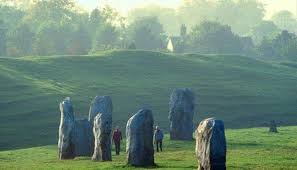
25
AprThe Mystery of the Standing Stones
 What sounds like the title of a Nancy Drew novel is actually my most recent fascination. In Britain they call them stones, but they’re really rocks—big ones. I’m referring to the roughly 1300 Neolithic monuments found throughout the U.K. known as stone circles and standing stones.
What sounds like the title of a Nancy Drew novel is actually my most recent fascination. In Britain they call them stones, but they’re really rocks—big ones. I’m referring to the roughly 1300 Neolithic monuments found throughout the U.K. known as stone circles and standing stones.
I just got back from my daughter’s wedding to her British beau in the Cotswolds. Having crossed the pond for the nuptials–and paid the annoying surcharge to check a bag–my husband Brad and I were in no great hurry to leave. We hired a car and drove four hours on the wrong side of the road to Cornwall, the rocky peninsula at the southwest tip of England that’s warmed by the Gulf Stream–allegedly. It wasn’t exactly balmy, despite the presence of palm trees, but it was definitely picturesque. Devotees of Poldark, Doc Martin, or the BBC mini-series of Daphne du Maurier’s Jamaica Inn might recognize some of the scenery.
We looked forward to hiking the cliffs, taking photos of fishing boats and quaint villages, and feasting on traditional Cornish pasties and cream teas. What I didn’t anticipate was how our first stop at the Avebury Stone Circles would spark an obsession with searching out smaller versions of the same over the next few days.
It was cool and misty the next morning as we contemplated the stones from our window seat at the inn during our first full English breakfast. If you’re not a fan of cooked tomatoes, beans, and blood sausage, I suggest passing on this quintessentially British staple. We had planned on a brief walkabout before making our way to Stonehenge but were persuaded to join a tour with a volunteer from the National Trust. I’m so glad we did.
You can stroll right up and touch the lichen-covered stones here, the largest prehistoric stone circle in the world. From our knowledgeable guide–big on enthusiasm but oblivious to the cold and damp that reduced our numbers to a mere four by the end of the tour–I learned the definition of “henge.” It’s a circular bank with a ditch on the inside, indicating it was not built for defensive purposes.
The village of Avebury, including our humble inn which I’d highly recommend save for the blood sausage, lies smack in the middle of this Neolithic, or Stone Age, marvel. It’s also the only stone circle that contains a pub and a chapel. Tragically, pious Avebury residents in the 14th century toppled and buried dozens of what they deemed to be pagan stones. 400 years later their descendants smashed and, uh, repurposed many of the remaining stones to build stuff. It seems Avebury was designated a protected UNESCO World Heritage Site a few centuries too late.
Fortunately, antiquarians William Stukeley and John Aubrey mapped much of the site during the 17th century before its destruction. Most of these rocks remained buried until the 1930s when archaeologist Alexander Keiller led a project to excavate and replace them in their original positions. Also unearthed was the skeleton of one of the original stone tippers, no doubt crushed to death, who was dubbed the Barber Surgeon based on the pair of scissors found nearby.
The million-pound question remains. Considering the… monumental time and effort required, why were these megaliths erected in the first place? Archaeologists believe they were probably used for ceremonial purposes, or in some cases, as solar calendars. Others have suggested they represented an attempt to appease the malevolent powers of nature, to commemorate the final battle of King Arthur, or that Native Americans from the Appalachians—or even the Druids–were involved. Lacking written records, we can only surmise. The theory that the tall slender stones and the shorter, wider ones stood for male and female seems reasonable enough to me.
Anxious to reach Cornwall before dark—and peel off our wet socks–we decided, somewhat reluctantly, to forgo Stonehenge. Distracted by the scenery and the surfers, I forgot about the stone circles for a bit. While Brad navigated the narrow lanes bordered by thorny hedgerows, I tried to stay on top of the pile of maps, books, and brochures rising steadily at my feet. One site that kept cropping up was the Merry Maidens Stone Circle.
We were heading back to our little Cornish cottage, but this called for a detour. Minutes later we pulled into the tiny lay-by, climbed over the stile, and there it was. I was instantly transported back in time, imagining those who had trod this same path and what had brought them to this mysterious ring of 19 rocks in the middle of nowhere.
According to myth, the Merry Maidens got its name from a group of ladies enjoying a night out on the turf who lost track of time and danced into the Sabbath. Greatly displeased, God turned the women to stone as a warning to others. It was so pleasant and peaceful among the stones that only the promise of seeing a nearby burial mound, believed to be the tomb of a local chief from 2000 BC, got me to bid the Maidens goodbye. But having met them, whenever we saw a Standing Stone on our map, we were on a mission.
Not entirely sure where we were going, we pulled into a farm, tromped through a field, scaled another stone wall and were rewarded by the sight of a lone 10’ high slanting stone. Unable to pass up a cheesy photo op, we pretended to hold it up like tourists at the Leaning Tower of Pisa. We spied another tall stone in the adjoining field and realized to our delight that we had stumbled across the Pipers. According to legend, the pipers who played for the maidens were also turned to stone as punishment for performing on Sunday. I love stories like that.
Driving back to London for our flight home, I had that slight let-down feeling you get when you leave a place that moved you and wonder if you’ll ever be back. Traffic on the A30 was stop and go when Brad suddenly exclaimed, “There’s Stonehenge!” In the distance stood the iconic monoliths silhouetted against the late afternoon sky. I’d been there decades ago, before they put up the barriers, but it was still breathtaking. Moments later we picked up speed and it was gone.
Had I known I’d become fixated with stone circles I would have checked out some of the many books on the subject available through the Minuteman Library Network before my trip. Circles and Standing Stones: An Illustrated Exploration of Megalith Mysteries of Early Britain, by Evan Hadingham, and Aubrey Burl’s Rings of Stone sound intriguing, as does The Atlas of Sacred and Spiritual Sites by David Douglas. To see the truly awesome nature of these enigmatic monuments, check out the DVDs Britain’s Treasures: An Aerial Journey and Standing with Stones: a Journey through Megalithic Britain. I plan to look at all these and more. After all, there are still hundreds of stone circles standing around patiently waiting to be discovered.
April Cushing is the Adult Services Librarian at the Morrill Memorial Library in Norwood, MA. Look for her article in the April 25, 2019 issue of the Norwood Transcript & Bulletin.
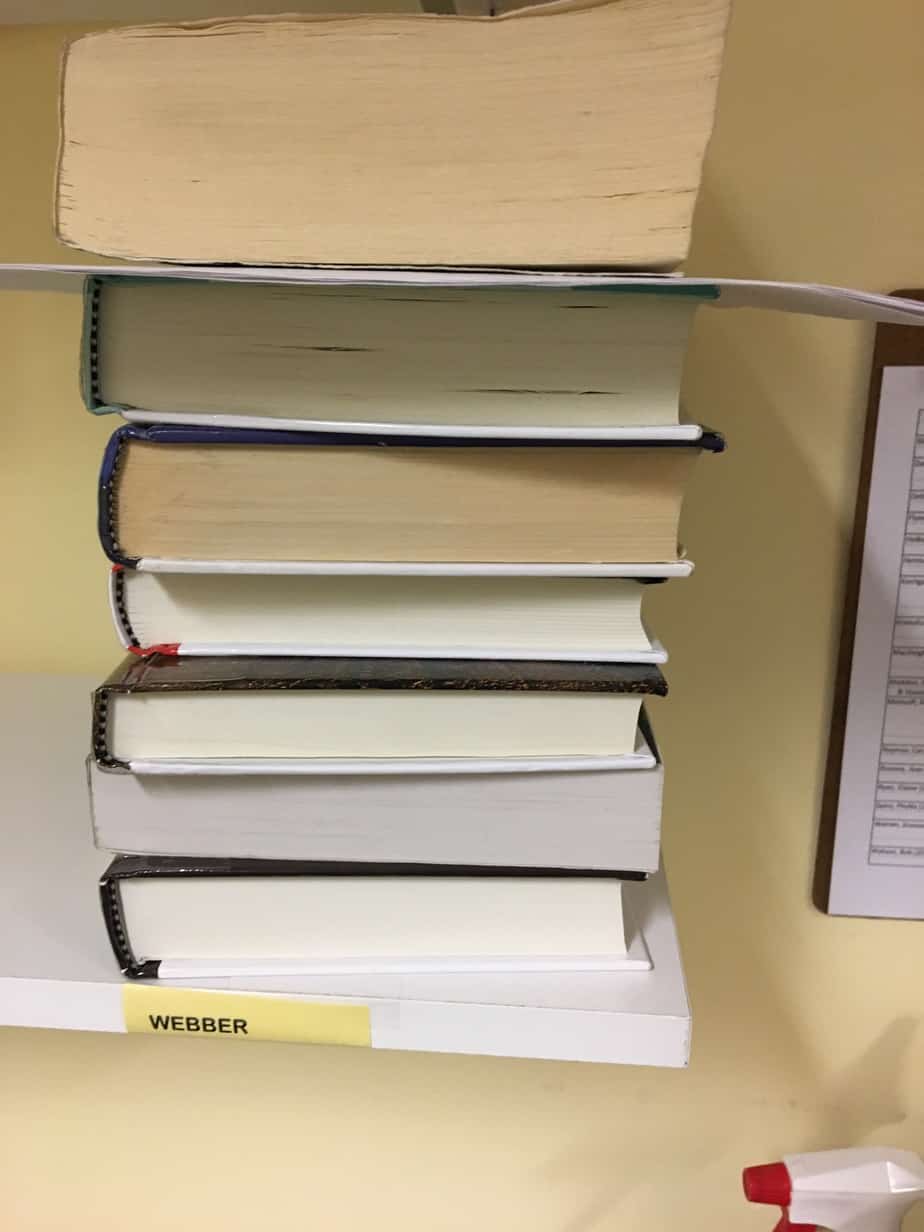
18
AprDear Beloved Reader
 In many ways the 21st century public library and its role have been re-imagined. In this digital age the library has become much more than a repository for great books. Libraries are promoters of community as well. Take a look at the Morrill Memorial Library events happening in the month of April alone. We have everything from Musical Sundays to talks on Stone Carvers of Old – from Beginning Yoga to The Secret Lives of Owls.
In many ways the 21st century public library and its role have been re-imagined. In this digital age the library has become much more than a repository for great books. Libraries are promoters of community as well. Take a look at the Morrill Memorial Library events happening in the month of April alone. We have everything from Musical Sundays to talks on Stone Carvers of Old – from Beginning Yoga to The Secret Lives of Owls.
Part of our shifting role includes providing information on the run. As mentioned by the Brookings Institute, “This ‘go-to’ role has influenced library programming and events, with libraries providing advice and connections to health, housing, literacy, and other areas.” Or, in author Neil Gaiman’s words, the library is “a community space. It’s a place of safety, a haven from the world.”
And yes, I could not agree more. In this digital world the library serves as a connector, providing access to information through workshops and speakers and more. At the heart of it all though, the library returns to two essential ingredients 1) free access to information and 2) our beloved readers.
In many ways the idea of free information for all began in Franklin, MA. The Franklin Public Library is considered America’s “first public library” because of Dr. Benjamin Franklin’s book donation for the use of the town’s residents in 1778. The original Franklin collection is still housed in the library’s Reading Gallery, and the United States is now populated by public libraries from sea to shining sea. According to the American Library Association, an estimated 116,867 public libraries exist today. Thankfully, the Morrill Memorial Library is one of them.
Several times at the library I have been approached by a person who recently immigrated to the United States. They cannot believe that our programs and services are free; this world is at their fingertips. Not only is this true here, but in the next town, and the town after that, and the one across the state, and across the country.
Which leads to the other essential ingredient at the heart of our libraries—our beloved reader, the person who lives and breathes for a good book. The person who enters the library, whether child or aged 102, with an empty tote bag, excited to fill it with 5, 10, 15 new reads. For FREE!!
During my years working in the Outreach Department, I have had the privilege of becoming a friend to many beloved readers. Often they are unable to come to the library on their own, so our volunteers deliver books and other items to them. While they miss browsing the bookshelves, they are grateful when these treasures arrive at their doorstep. It’s like a having a birthday every few weeks.
I have worked with many of these beloved patrons over the years but a few have stood out in my mind. Annette Webber was surely one. Sadly, she passed away this March just shy of her 93rd birthday. Every other week her Outreach volunteer delivered about 15-20 books to her. The most amazing thing was her interests were limitless. Not only did she reread To Kill a Mockingbird by Harper Lee but she gave Lee’s latest novel Go Set a Watchman a try as well. She always loved biographies, especially about politicians. The Kennedy Debutante by Kerri Maher and A Well-Behaved Woman: A Novel of the Vanderbilts by Therese Anne Fowler were two of her latest. However Annette could not be pigeon-holed onto a certain shelf. All-American Murder: The Rise and Fall of Aaron Hernandez, the Superstar Whose Life Ended on Murderers’ Row by James Paterson and Alex Abramovich was also one of her reads, along with Gold Dust Woman: The Biography of Stevie Nicks by Stephen Davis.
Sylvia Clark was another life-long learner. I first met Sylvia when I was running a book discussion at Benchmark Senior Living. She had lost much of her eyesight from macular degeneration but as soon as she realized she could borrow a CD player and audio books from the library, she signed right up. Later I learned that she was an educator who had taught at Maynard High School, Needham High School and Regis College. How I marveled that she was willing to become an auditory learner when necessary. Historical fiction was a favorite genre of hers and she relished books like Unbroken by Laura Hillenbrand, All the Light We Cannot See by Anthony Doerr and The Lilac Girls by Martha Hall Kelly. That said she could tackle a mystery series with equal aplomb, so we would toss in a James Patterson or Daniel Silva novel to keep her going.
Of course these are just two examples of the many beloved readers who have loved the library and all its treasures. It’s nice to know our patrons need the library as much as the library needs them. While the library has stepped boldly into the 21st century, our doors are always open to the patron who is searching for the perfect read.
Nancy Ling is the Outreach Librarian at the Morrill Memorial Library in Norwood, MA. Look for her article in the April 18, 2019 issue of the Norwood Transcript.
